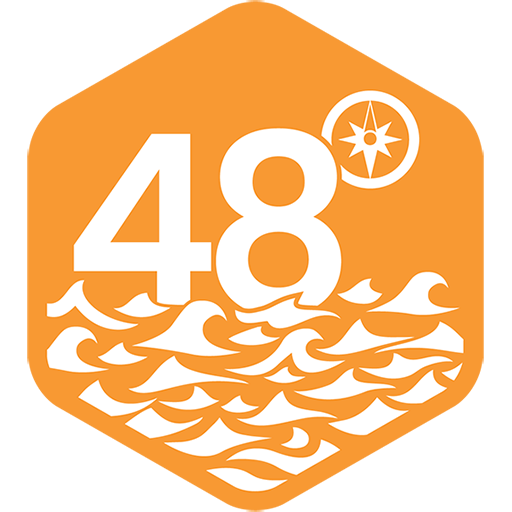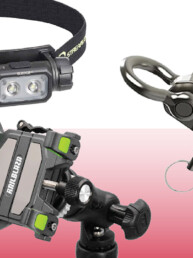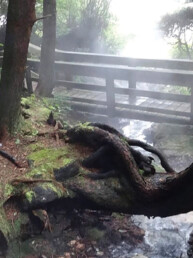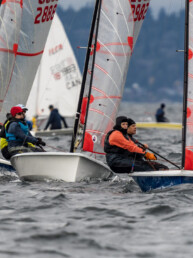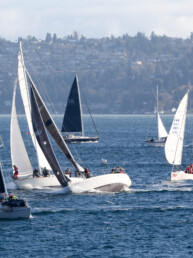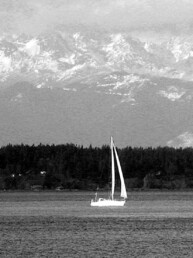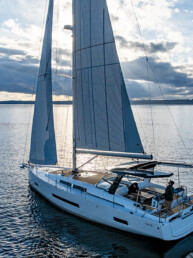From a light air morning start to a full on gale building at night, this year’s Southern Straits Race was a slow-motion, fast-motion affair.
Southern Straits is always held over Easter Weekend and this year Easter was in late April, just about the latest possible date for the first Sunday after the first full moon after the first day of spring. Would that mean a warmer, gentler Southern Straits? It was definitely warmer in general, except that 35-40 knots doesn’t feel warm, regardless of the air temperature around here.
We were racing on Ripple, our new-to-us Bieker designed 1996 Riptide 35 MkI. After a few false starts with very light winds and a few things to sort out on the boat since we acquired her late last summer, this was to be our first proper race: The 100-mile Sisters Islets long distance course for ORC rated boats.
With some reformatted race course options this year, racers had three distance race options: the Sisters Islets course we had chosen, as well as the 55-mile Entrance Island course, and the 36-mile Halibut Bank course. The distance courses drew 66 boats in total and the inshore option had an additional four race boats.
The night before the traditional Friday start, Bruce Hedrick gave the racers at West Vancouver Yacht Club a weather blessing, which I will summarize as very light wind during the day and really windy all night. My hope was that we would have at least enough wind to start on time and get out of English Bay. Wish granted! Twenty minutes before the start, a 4-5 knot westerly showed up. That combined with a knot of favorable current, meant that: first, we had no issues beating out of the bay; and second, everyone was still very conservative at the start, for fear of drifting over early and not being able to get back to restart. That meant there were just a few risk-tolerant front row starters and a bit of a crowded third row.
Getting out of the Bay in 3-7 knots of wind was illuminating for us on Ripple. This was our first proper lineup with similarly rated boats in general, and we were excited to put our new J1.5 jib to the test. It turns out our little 29-year-old 35 footer is stupid fun to sail in light air as we led the 16 Division 1 boats out of English Bay, happily staying close to the 2012 Riptide 35 MkII, Longboard (who was sailing in Division 0).
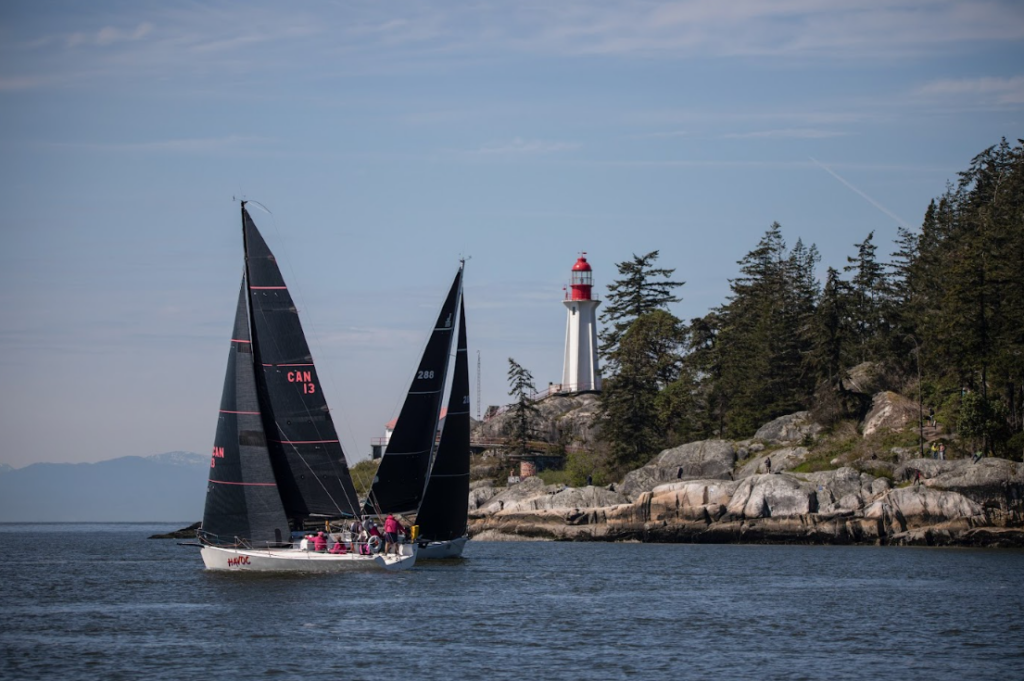
Then, it got lighter. Fortunately, we never stopped moving along the mainland shore, and it was never truly frustrating as it seemed everyone around us was experiencing the same conditions. It was just a sailboat race happening in slow motion at times.
It was about 5 p.m. when the forecast northwesterly showed up, and we enjoyed a super pleasant evening sailing upwind in 5-10 knots, still heading west-northwest across the strait since the fleet hadn’t made much progress in the light air. As the breeze filled and boat speeds became more interesting, Ripple was joined by a nice group that included the J/122e Joy Ride, XP-44 Phoenix, J/111 65 Red Roses II, Tripp 41 Bandit, and J/133 Blue Jay III. We were very pleased to find our boat speed was reasonable, and we could just focus on sailing fast and covering the competition. Competition that kept wanting to bang to the right side of the course. What was so enticing about that side?
When the breeze reached 14 knots, knowing it would continue to increase, we switched jibs. While the jib change went okay, we lost the plot on the strategy, tacking left to complete the peel and then forgetting to cover. Continuing southwest after the change, a 30 degree right shift arrived roughly 45 minutes later. While we had lost a few minutes switching jibs, we had just lost a few miles being on the outside of this huge shift. That was definitely not one of our smartest moves. Oops.
It got dark as we approached the south end of Lasqueti Island, and as it often happens, the breeze increased to a solid 15-20. The last 6 miles to Sisters was a little bit of a hate mission, made even more challenging since to date we had zero experience sailing Ripple upwind in over 15 knots doublehanded (I believe we were the only doublehanded boat in the long course this year. Bummer). The group of five Division 1 boats rounded Sisters about 6 miles ahead of us, and most of them, with one exception, threw up whatever small, heavy kite they had and strapped in for a guaranteed thrill ride for 50 miles back to the finish. On Ripple, we were happy to finally have a boat with an A5 kite. It is tiny and perfect for what was now breeze mostly in the low 20s and forecast to continue building.

The route back home included rounding Ballenas Islands to port. I think most boats had a perfectly spirited, but not alarming, 15 nautical mile run back to Ballenas. In the strengthening northwesterly, getting there was more of a true downwind leg. Oh, but after Ballenas was a whole other ball of wax, with a course that was 25 degrees tighter to the breeze paired with building winds.
The post-race dockside war stories seemed to confirm that the real race was simply how long you could keep your kite up. God certainly took a few down as the breeze increased to 25-30, then low 30s, and eventually topping out in the 35-40 knot range as boats reached the finish. The finish order in Division 1 reflected this. Tavish Minielly from 65 Red Roses II reported they managed to keep their full size A2 kite up until 3 miles from the finish when the spin halyard gave up, and “only broke 20 knots a few times.” It was a lucky break, as they ended up wiping out in a 40-knot puff as they crossed the finish line with just the main and jib, but they made it farther than most with their kite and that earned them the Division 1 and Overall ORC wins. Serious kudos to that very experienced team that put it all together in challenging conditions. For the numbers geeks, Roses gained 7-12 miles on the other Division 1 leaders in only about 35 miles. The understatement of the race was from Alyosha Strum-Palerm, guest crewing aboard the J/111 who said, “It is not trivial to drive (a J/111) when it is blowing 30.” No, not trivial at all.
For us on Ripple, we tapped out when we saw 25 knots, dousing the kite shortly after passing Ballenas. At that stage we needed either more people, more light, more practice, or ideally all of the above if we were going to keep the gas pedal on the floor. Other than a few brave and well-sailed boats in front of us, I think we were in the majority of the fleet with that plan. The courageous award must surely go to the Andrews 77, Mach II, who saw 32 knots of boat speed in a 40 knot puff near the finish! As sea stories go, is that a monohull speed record for the Salish Sea?
We learned a ton in a very short time racing on Ripple in this year’s slow-motion-fast-motion edition of Southern Straits, and we already have a nice list of things we can do better next time. In the end, we wound up 7th in our division and 15th overall in ORC. It is always amazing to rediscover how rewarding it is to challenge ourselves on our home waters.
While 65 Red Roses II were the big winners on the long distance Sisters Islets Course, the podiums on all courses were full of impressive performances. On the Sisters Islets course, Division 0 went to Peter Salusbury’s Longboard (Peter has now completed an incredible 50 Southern Straits Races!), and the J/109 Diva won Division 2. On the Entrance Islands Course, the Swan 46 Setri won Division 3, CY 8.0 Incisor won Division 4, and Division 5 honors went to the Windward 30 Pitoraq. On the Halibut Bank Course, GP26 Wraith took the Division 6 win and was also the top doublehanded boat for that course, and the Dufour 38 Radiance topped Division 7. On the Inshore Course, the Melges 24 Ferdinand came out atop the podium.
A huge shoutout to Race Chairman Peter Salusbury, PRO Kathy Parslow (and point person for the fantastic WhatsApp communication tool), and all the volunteers for making the 55th Southern Straits Race a welcoming, fun, very well-organized event. I suspect everyone agrees that the new virtual finish line—well away from the notorious Point Atkinson—was a success. It turns out that finishing in 30-40 knots downwind out in the middle of English Bay has its distinct advantages. What a wonderful and wild weekend of racing on the Strait of Georgia.
Full results available HERE.
Feature image courtesy of Randy Vogel.
